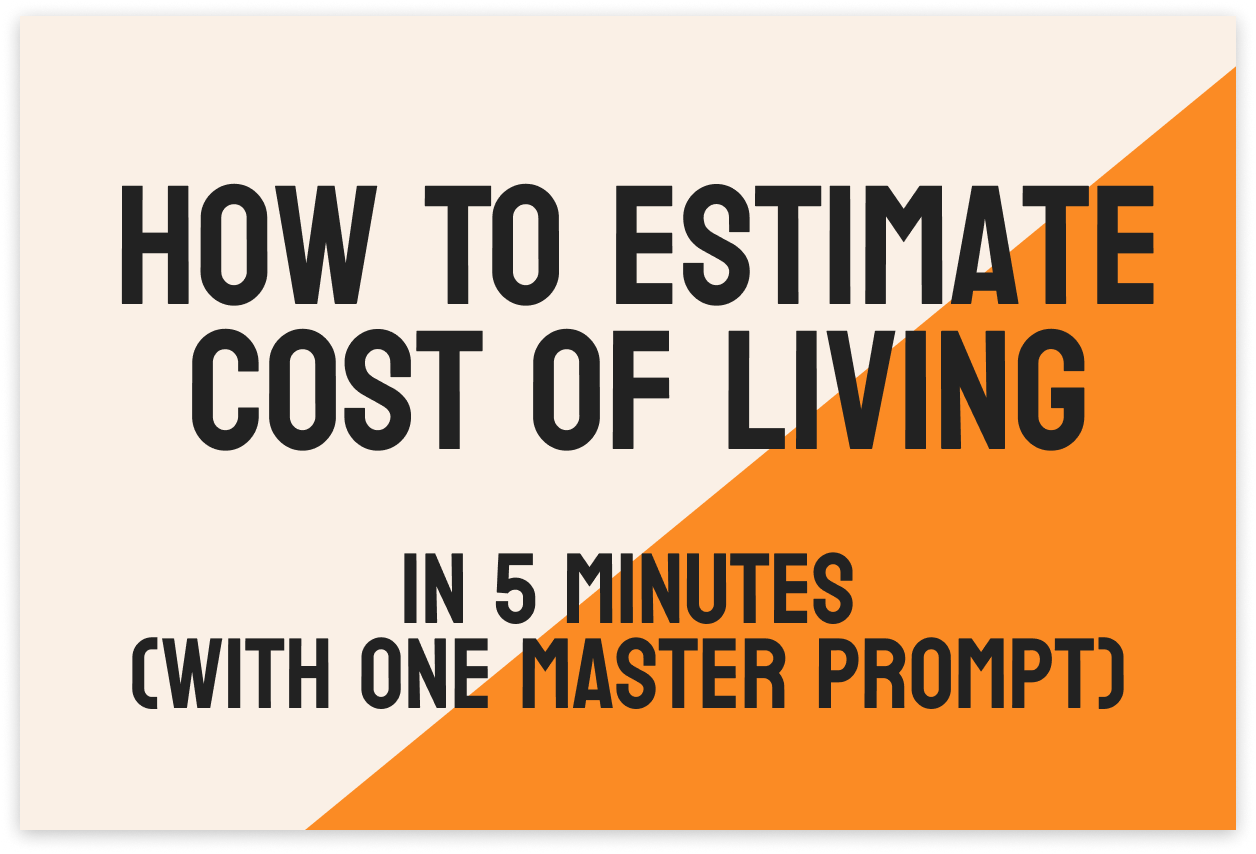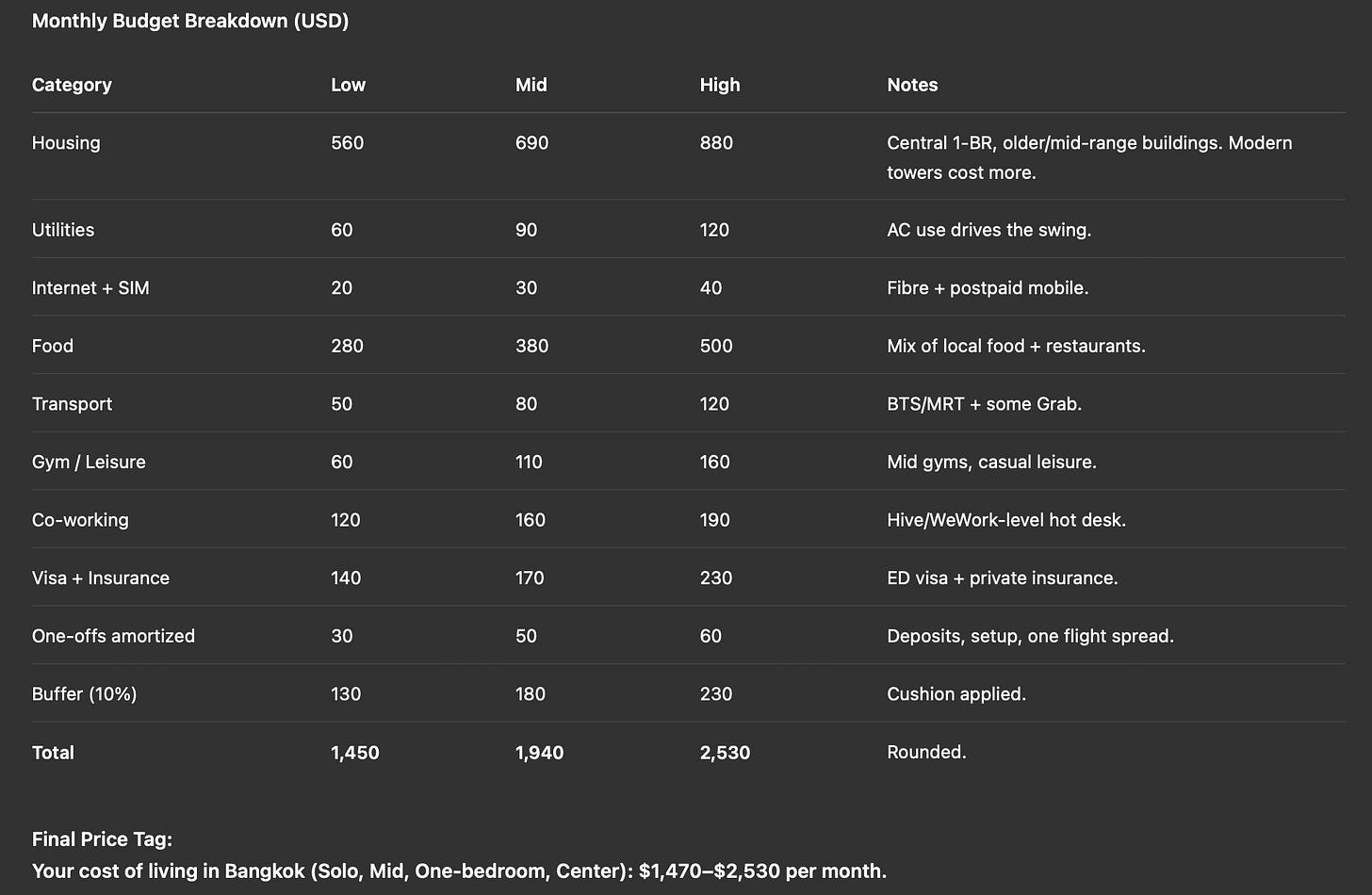How to Estimate Your Cost of Living Abroad in 5 Minutes (With 1 Master Prompt)
A simple prompt that turns cities into numbers.
You can price your life abroad in five minutes.
Most people go through blogs and old threads and end up more confused.
Costs vary by lifestyle, not just by city. A couple, a solo founder, and a family won’t spend the same.
You don’t need a perfect number. You need a reliable range that you can adjust.
Here’s what we’ll cover today.
A quick method that works for any city.
A simple way to avoid the usual mistakes.
A free prompt you can copy and use.
Then we’ll put it on a real example.
#1 Set Your Lifestyle Baseline
Before you look at prices, set a baseline.
Are you moving solo, as a couple, or with kids?
Do you want to live budget, mid-range, or premium?
Most cost-of-living numbers online are not wrong. They reflect someone else’s setup. Without a baseline, you’ll compare against the wrong lives.
Takeaway: Your baseline makes every number personal.
Do this now:
Write two lines.
Household type: Solo or Couple or Family.
Comfort level: Budget or Mid or Premium.
Note: Choose what you prefer today. When you run the prompt later, you can adjust if the numbers look off.
#2 Housing
Rent sets the tone for your whole budget.
In many cities it is the biggest line item. Once rent is clear, the rest lines up.
You only need two inputs here. Pick your housing type. Pick your location preference. Studio or one-bedroom or two-bedroom. City center or 20 to 30 minutes outside.
You might think, “I don’t know yet. It depends on price.”
That is fine. Write what you want now. When you run the prompt, it will pull the local rent range for that choice. If it looks too high or too low, change the input and run it again.
Takeaway: Decide housing type and location. The prompt will fetch the price.
Do this now:
Write two lines.
Housing type: Studio or One-bedroom or Two-bedroom.
Location: Center or 20–30 minutes outside.
Example: Inputs: One-bedroom. Center. The prompt will return the typical monthly rent range for your city and use it as the anchor for the rest of your estimate.
#3 Fixed Costs
After rent come the basics. Electricity. Water. Internet. Local SIM. Smaller than rent, but they hit every month.
These costs change by city and building. Hot places mean more air conditioning. Cold places mean more heating.
You don’t need to guess. Once your city and housing are set, the prompt will add realistic local ranges for your setup.
Takeaway: Fixed costs depend on location and building. Let the prompt include them.
Nothing to decide. Just note these exist. The prompt will add them automatically.
#4 Your Variable Basket
This is where lifestyle shows up: food, transport, gym, and leisure.
These are flexible costs. They depend more on your habits than on the city.
Cooking at home versus eating out changes the number a lot. Public transport versus Uber does the same. Gyms, cafés, and weekend trips all sit in this basket.
You don’t need to price every meal or taxi.
The prompt will use your baseline (budget, mid, premium) to assign realistic ranges for food, transport, and leisure in your chosen city.
Takeaway: Variable costs reflect your habits. The prompt adjusts them to your baseline.
Nothing to calculate. Just remember that your comfort level from step one drives this basket.
Example: Inputs (still the same as before): Solo. Mid-range. One-bedroom. Center. The prompt adds mid-range food, transport, and leisure costs for your city and folds them into the monthly estimate.
#5 Visas, One-Offs + Buffer
So far you’ve covered the main pieces: housing, fixed costs, and daily living.
What’s left are the extras that don’t show up every month but still matter.
Things like visas, health insurance, flights home, co-working, or a gym membership upgrade.
Some are annual, some are one-time. Ignoring them makes your budget look cheaper than it is.
You don’t need to guess the numbers. The prompt can pull visa and insurance fees for your country, then spread them across the year.
Flights or one-off setup costs can be added later if they apply.
Takeaway: Extras add up. Let the prompt annualize them and include a margin for surprises.
Do this now:
Decide if you want a safety buffer. Most people add 10–15%. That cushion keeps you safe when bills or travel pop up.
Example: Inputs: One-bedroom. Center. Mid-range. Add 10% buffer. The prompt will return a monthly total that already includes insurance, visa fees, and a margin for unexpected costs.
Clarification on Comfort Level vs. Table Ranges
When you choose Budget, Mid, or Premium as your Comfort Level, the entire estimate will be built around that lifestyle.
But since nuance matters, within each lifestyle, there will be 3 tiers (Low / Mid / High):
The Low / Mid / High numbers in the table are not three different lifestyles.
They are the range inside your chosen lifestyle.
Low = lean version of that lifestyle (living frugally or unusually cheap month).
Mid = typical version of that lifestyle (what most people at this level spend).
High = upper version of that lifestyle (same lifestyle, but with extras).
I Tested It
I tested this prompt across many examples and refined it until it made sense.
But …
… you should still treat it as a starting point, not a final answer.
Everyone’s lifestyle has its own nuances, from conversations with many of you, I know some people care for dependents, others have pets, and so on.
If you have special circumstances, you can simply continue the conversation with GPT (or any LLM you use) and refine your overview. Treat it like a sparring partner.
What this prompt gives you is a solid baseline, instead of relying on generic cost-of-living numbers that can be misleading.
Here’s the prompt:
ROLE
You are a global mobility analyst. You build realistic monthly cost-of-living estimates for a city based on a few inputs. Use DEEP THINKING MODE. Think carefully before calculating. If something is uncertain, explain the assumption and proceed.
GOAL
Return a clear monthly estimate with line items, ranges, and a final total. Show what moves the number up or down. Keep the language plain and practical.
INPUTS
• City = <enter city>
• HouseholdType = Solo / Couple / Family
• ComfortLevel = Budget / Mid / Premium
• HousingType = Studio / One-bedroom / Two-bedroom
• LocationPreference = Center / 20–30 minutes outside
• BufferPercent = 0–20 (default 10)
• Options (if relevant): Co-working Yes/No, Car Yes/No, Kids/Schooling Yes/No
METHOD
1) Anchor on housing.
• Find a realistic rent range for the given HousingType and LocationPreference in the chosen City.
• If browsing is available, triangulate from at least two reputable sources. If not, use well-known local patterns and typical price bands. State the source logic.
• Return a monthly range in USD.
• IMPORTANT: Always add a note if the “budget” rent assumes older stock or smaller units that are cheaper than expat averages. Example:
“These figures reflect the low end of one-bedrooms in the city center — often older condos or smaller units. If you prefer a modern expat-style building in prime areas, expect higher prices (closer to expat averages).”
2) Add fixed costs.
• Utilities: electricity, water, gas or heating, plus building fees if typical.
• Internet and local SIM.
• Base these on the City and common building types for the chosen HousingType and LocationPreference.
• Explain climate drivers briefly. Example: air conditioning in hot cities, heating in cold cities.
3) Add the variable basket.
• Food at home vs eating out. Transport. Gym. Coffee and small leisure.
• Use HouseholdType and ComfortLevel to set realistic ranges.
• State the key habits that move the number. Example: eating out frequency, rideshare vs public transport.
4) Add visas, insurance, and one-offs.
• Visa fees and expat health insurance typical for the City’s country. If visa type varies, choose a common legal path for the HouseholdType and ComfortLevel and explain the pick.
• Annualize one-offs that matter for year one. Example: flights home, deposits, setup items. If unknown, use a sensible placeholder and mark it as adjustable.
5) Apply buffer.
• Apply BufferPercent to the subtotal to cover surprises and small misses.
COMFORT LEVEL CLARIFICATION
When you choose Budget, Mid, or Premium, the estimate is built entirely around that lifestyle.
The Low / Mid / High values in the table are not three different lifestyles. They are the range inside your chosen lifestyle:
• Low = lean version (cheapest realistic month).
• Mid = typical version (what most people at this level spend).
• High = upper version (same lifestyle, but with extras or higher bills).
Example: If you select Budget, you’ll see low-budget, mid-budget, and upper-budget ranges — all still budget living.
OUTPUT
Produce the following in Markdown with these reader-facing titles:
1. Quick Snapshot
• City and inputs echoed back.
• Monthly total range in USD.
• Cost per person if HouseholdType is Couple or Family.
2. Monthly Budget Breakdown
Show all numbers in USD only.
| Category | Low (USD) | Mid (USD) | High (USD) | Notes |
| Housing | ... | ... | ... | include the “budget vs expat average” clarification if relevant |
| Utilities | ... | ... | ... | climate driver |
| Internet + SIM | ... | ... | ... | typical plan |
| Food | ... | ... | ... | at-home vs eating out |
| Transport | ... | ... | ... | transit vs rideshare |
| Gym / Leisure | ... | ... | ... | typical habits |
| Visa + Insurance (monthly) | ... | ... | ... | path chosen |
| One-offs amortized (monthly) | ... | ... | ... | what is included |
| Buffer | ... | ... | ... | BufferPercent applied |
| **Total** | **...** | **...** | **...** | |
3. What Happens If You Change Things
• If housing moves from Center to 20–30 minutes outside, show the new total.
• If eating out doubles, show the new total.
• If BufferPercent is set to 0, show the new total.
4. Easy Ways to Cut Costs
• One housing lever.
• One lifestyle lever.
• One admin lever. Example: different visa or insurance tier.
5. If the Numbers Don’t Feel Right
• If too high, suggest one housing change and one lifestyle change.
• If too low, suggest one comfort upgrade and one location upgrade.
6. What Life Feels Like Day to Day
• One paragraph on trade-offs that a newcomer actually feels in this City.
7. Final Price Tag
End with a single, bold USD range on its own line:
**Your cost of living in <City> (<HouseholdType>, <ComfortLevel>, <HousingType>, <LocationPreference>): $X–$Y per month.**
Nothing after this.You only need to fill in the “Inputs” (third paragraph).
Let me know in the comments, how it worked for you!
P.S.
If you don’t want to figure this out alone, I offer 1:1 support.
Read more at theclubcitizen.com.
Appreciate you being here,
— Ben




